|
2C Update #133 -
Vava'u, Tonga Part
2 (September
15 - November 29, 2005)
We hadn’t been in
Tonga’s Vava’u island group five days before we knew we
weren’t going to have enough time here. Our projected
schedule allowed us one month -- maybe six weeks -- to
explore all the treasures of this archipelago and the
Ha’apai Group to the south-- before we ought to be
hightailing ourselves off to Fiji for our reservation at
Vuda Point Marina. Drats!!
So far we’d only
been in two anchorages: Neiafu’s harbor and the
exquisite curve of reef we’d anchored behind for the
previous weekend’s full moon party. With the dust
settled from the party and the fifty-some cruising boats
which had brought all the partygoers dispersed, we could
have sat happily right where we were for weeks! At
least we could have, assuming the weather would stay as
perfect as it had been, since the spot was bit exposed
at high tide. Being realistic, unending perfect weather
was not very likely, so we finally snapped to and
realized that if we wanted to see some more of Vava’u
before our time ran out, we’d better get to it.
There is a chart of
Vava’u produced originally by the Moorings for their
customers that identifies all the anchorages in Vava’u
by a number system. Although it takes away a bit from
the charm of being in exotic sounding places, it does
simplify things for visitors struggling with
hard-to-pronounce place names, especially since there
are forty-two of them marked. As you might guess, Don
likes the number system and I like the place names, so
nothing has gotten simplified on our boat.
There is also a
terrific cruising guide for the area, (actually for all
of Tonga) called Sailingbird’s Guide to the
Kingdom of Tonga by Charles Paul and Katherine
Pham-Paul. Of nearly coffee-table book quality, full of
color photographs and chartlets and interesting
sidebars, this is a book we had not bought at Bluewater
Books, since we already had the Comprehensive
Cruising Guide for the Kingdom of Tonga by Ken
Hellewell, which came out two years earlier and
unfortunately isn’t near so nice. Fortunately, Kathi
and Dave of sv Sunflower, whom we’d met in
Niuatoputapu, felt strongly enough about it to insist we
borrow their copy, and I’m so glad because I wonder if
we would have enjoyed these islands as much without it.
As I described in
the last Update, the main island of Vava’u – the one
that gives the island group its name – lifts its north
face high out of the sea in sheer cliffs and then slopes
away southward. South of the big island of Vava’u is a
middle belt of middle-sized islands, that hang southward
in strands (kind of like the tentacles of a jelly fish!)
and amongst these islands are the famous fjiord-like
waterways and the most protected anchorages. To the
south the north-south strands are bounded by an arching
band of submerged reef running west to east topped here
and there by small islands with beaches, while south of
that band is a thin scattering of tiny round sand islets
topped by green and fringed by reef. The geological
explanation is that all of Vava’u is a single tilting
limestone block, but there is a fable that I like
better. It says that Vava’u was created when the god
Tangaloa went fishing and hooked his line on the bottom
pulling up the islands from the sea.
|
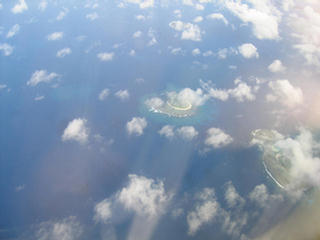 |
 |
Since conditions
continued to be very settled, we set out to check out
one the spray of unprotected islands south of the reef
band. The one we chose was Luahiapo (#35), more or less
in the middle of the spray, but it could have been any
of a dozen others (had we not confirmed it with our
chartplotter), so alike do they look: perfect little
circles of sand with centers of green and fringing reefs
encircling them. After finding a spot of sand to anchor
in on Luahiapo’s NW edge, we jumped in to snorkel the
crystal clear waters, Don armed with his speargun. I
think I misread the text when I got the impression that
fishing might be good here. Right under the boat was a
towering coral bommie coming up twenty feet from the
bottom with some sizeable fish keeping just out of Don’s
diving range, but to our surprise all the other the
coral in sight was low-lying, like a field of cabbages
and cauliflower. In close to the islet we found one
ravine full of fish at a good depth, and Don took a
couple of shots with his spear gun only to discover his
bands had grown weak from age and disuse. No joy for
the hunter today. Away from the ravine over the low
coral slope the fish life seemed sparse. After a long
but fruitless swim we took the dinghy all round the
island hoping for better hunting. What amazed me each
time I popped in the water to look was the island’s
underwater shape. The island and its reef appeared to
sit plopped atop a pincushion of sand! What holds the
sand together in that shape? Why doesn’t it all just
slide downhill? Although we returned to the boat for
lunch feeling a bit thwarted in our goal of finding
spectacular diving, the trip out was not disappointing
because for the first time in a long, long time we felt
totally alone, so remote we could relax after our swim
au natural, if you catch my drift -- no mean
accomplishment in this part of the world.
In contrast our
first choice of a night anchorage at the island called
Taunga (Tah-oong-ah) (#23) was clogged with a group of
this year’s puddlejumpers who seem to go everywhere in a
pack! Instead of stopping, we bore away north to anchor
alone off Nuku, a spur of an island off the southwest
tip of Kapa. Nuku features a long snow-white sand spit,
and we dropped our hook in shallow water behind the spit
letting the boat blow back over a drop-off of much
deeper water.
We woke the next
morning to the end of the settled weather. The sky was
gray, the wind blowing, and here we were hanging
precariously off the edge of a drop-off! However the
spit kept the water flat while the wind made the wind
generator sing. Don swam the anchor several times, but
despite its precarious position, all stayed well-set and
unchanged, so we continued to sit contentedly there a
second day, snorkeling in the island’s lee and pursuing
onboard projects.
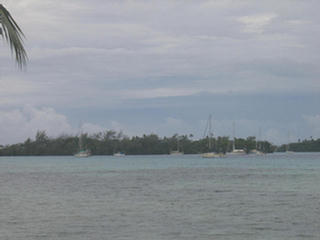 Unfortunately, the
unfriendly weather did not relent, so we moved on,
motoring into the wind along the south end of Kapa and
its tricky offshore reefs, before setting the genoa for
a fast tack up to anchorage #11. This anchorage is one
of the best protected in the group wrapped around as it
is by Pangaimotu and Tapana Islands. It is one of the
most popular anchorages with Vava’u cruisers because
there are not one, but two Tongan feasts presented
weekly on adjoining beaches, there is the very popular
La Paella restaurant run by some former cruisers from
Spain, and, at the center, the charming little ARK
Gallery. And if that isn’t attraction enough, there is
a road to town from the beach, which makes it very
convenient to sneak back into town by taxi for
provisions. Unfortunately, the
unfriendly weather did not relent, so we moved on,
motoring into the wind along the south end of Kapa and
its tricky offshore reefs, before setting the genoa for
a fast tack up to anchorage #11. This anchorage is one
of the best protected in the group wrapped around as it
is by Pangaimotu and Tapana Islands. It is one of the
most popular anchorages with Vava’u cruisers because
there are not one, but two Tongan feasts presented
weekly on adjoining beaches, there is the very popular
La Paella restaurant run by some former cruisers from
Spain, and, at the center, the charming little ARK
Gallery. And if that isn’t attraction enough, there is
a road to town from the beach, which makes it very
convenient to sneak back into town by taxi for
provisions.
The Ark Gallery is a
small colorful houseboat moored in the lee of a narrow
bit of island in the center of the bay. It is so
protected in this spot that the Ark and any boat that
picks up one of its rental moorings are liable to sit
back winded even as the nasty weather blows right over
the top. We dinghied in to check out the gallery’s
offerings: mostly the work of its owner, Sheri
Schneider, but also selected crafts of local Tongan
artists. A self-taught artist, Sheri does small
paintings of local scenes that she reproduces and mounts
in frames of locally printed tapa cloth. She also does
hand-painted T-shirts of underwater scenes, and you can
arrange with her to do a custom portrait of your boat.
Sheri’s husband Larry runs the daysail trimaran Orion in
between doing boat deliveries to New Zealand and the
States. In fact, it didn’t take us long to find out
that Larry’s latest delivery to the States was none
other than the Ericsson 39 Danseuse de la Mer belonging
to Mike and Mary-- our cruising buddies of last year.
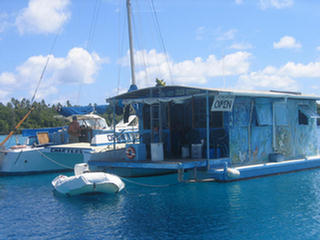 |
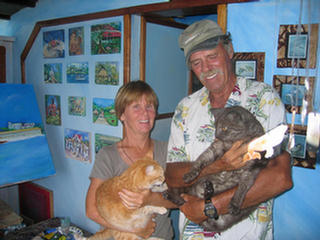 |
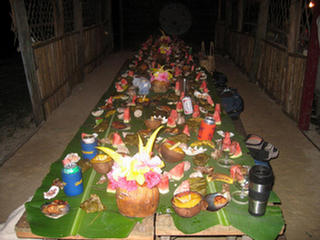 That evening we went
ashore to the Tongan Feast on Hinakauea Beach. Like the
Samoan feast we went to at Teesa’s in American Samoa,
the food is prepared in an umu, but unlike that
one, this weekly feast is put on not by a restaurant,
but by a community as a way to raise money. The low
tide beach was not easy to get into, but schoolboys
waded out to guide us in via a channel someone had
picked clear of rocks. Ashore we found a long hut with
a table for about thirty people inside set with banana
leaves and flowers, while outside on the lawn was
arranged an avenue of crafts-people selling their wares,
reminiscent of the revolving band of vendors who’d
followed the tourists around Easter Island. We had not
come prepared to shop, but it was a good opportunity to
get a first look at the kinds of crafts available in
Tonga -- mostly baskets of every shape and size,
carvings large and small of wood or bone (usually cow
bone), pandanus mats and great sheets of tapa
cloth. That evening we went
ashore to the Tongan Feast on Hinakauea Beach. Like the
Samoan feast we went to at Teesa’s in American Samoa,
the food is prepared in an umu, but unlike that
one, this weekly feast is put on not by a restaurant,
but by a community as a way to raise money. The low
tide beach was not easy to get into, but schoolboys
waded out to guide us in via a channel someone had
picked clear of rocks. Ashore we found a long hut with
a table for about thirty people inside set with banana
leaves and flowers, while outside on the lawn was
arranged an avenue of crafts-people selling their wares,
reminiscent of the revolving band of vendors who’d
followed the tourists around Easter Island. We had not
come prepared to shop, but it was a good opportunity to
get a first look at the kinds of crafts available in
Tonga -- mostly baskets of every shape and size,
carvings large and small of wood or bone (usually cow
bone), pandanus mats and great sheets of tapa
cloth.
Next on the agenda
was a show of native dances performed by local children
to music and song provided by their parents and
grandparents. While some of the youngsters enjoyed
being the center of attention, others looked like being
“on stage” in their skimpy attire was excruciatingly
terrifying. The tradition in these parts is to stick
paper money to the oiled skin of the dancers, and since
the objective of the show was to raise money for their
school materials, lots of money got tucked into tiny
bodices! (Hint: Go prepared, bring lots of $1 or 2
paanga bills!) Tongan dance is more like Samoan
dance than Tahitian or Hawaiian, with the bulk of the
action in the motion of the hands and arms, except for
the dances of the “men” which are quick, aggressive and
accompanied by war-like grunts and cries. The boys, who
danced with sticks reminiscent of English sword dancing,
looked like they were having a lot more fun than the
little girls. At the end they all picked partners from
the watchers to dance with them. As usual, Don was one
of the first picked.
The meal was very
good. With all the palangi (foreigners) arranged
on benches the length of the table, the food was placed
artfully at each place directly on the banana leaves or
in clam shell “dishes”, and with no silverware (or
napkins), it is all eaten with the fingers. Knowing
Don’s feeling about finger licking, I’d come armed with
paper towels. Although many dishes were similar to ones
we’d had at Teesa’s Samoan feast -- specifically the “lus”
of coconut cream, onion and meats cooked in wrappers of
taro leaf (see Galley #30 & 31), there was much less
emphasis on meat and more on seafood. We had ota ika,
the Tongan version of poisson cru, roasted octopus and
fish, the inevitable pork, and of course the whole array
of local starches -- taro root, breadfruit, and
plantain. Although the umu itself was somewhere
out of sight, food kept coming if you kept eating!
 Afterwards we were
invited to have our first taste of kava. Kava is made
from the root of a pepper plant. Traditionally the root
was chewed to soften it, then steeped in water, and
wrung out into a special kava bowl to make the mildly
intoxicating beverage that is (or at least was) the most
important ceremonial element of any gathering of men.
These days you can buy kava powdered. It was served to
us from the bowl into coconut cups, while musicians
seated on the floor placed some background music on a
ukulele and banjo, and while it wasn’t the tastiest
thing we’ve ever quaffed, and I think it takes quite a
bit more than we were interested in drinking to get
intoxicated, it definitely had a numbing action on the
lips and tongue! Afterwards we were
invited to have our first taste of kava. Kava is made
from the root of a pepper plant. Traditionally the root
was chewed to soften it, then steeped in water, and
wrung out into a special kava bowl to make the mildly
intoxicating beverage that is (or at least was) the most
important ceremonial element of any gathering of men.
These days you can buy kava powdered. It was served to
us from the bowl into coconut cups, while musicians
seated on the floor placed some background music on a
ukulele and banjo, and while it wasn’t the tastiest
thing we’ve ever quaffed, and I think it takes quite a
bit more than we were interested in drinking to get
intoxicated, it definitely had a numbing action on the
lips and tongue!
The next morning
during coffee a craft vendor took a second shot at us
coming by boat into the anchorage. Pita and Petiola
rowed up with their two granddaughters and after about
fifteen minutes of chit-chat we found ourselves not only
in possession of a club about the size and shape of a
baseball bat carved with the somewhat alarming visages
of the Gods of Peace and Love (!!!) but with a date to
join Petiola for church on Sunday! The two captains are
not normally churchgoers, preferring to express our
appreciation of life directly with Mother Nature, but
Christianity is such an important part of life here that
many cruisers make a point to attend a service at least
once. One of the really amazing things about Tongans is
that there is no judgement evident about our different
ways and beliefs. They expect our ways to be different
and absolutely no one is trying to convert you to
anything. All they ask is that we palangi
respect their traditions, one of the most important of
which is to honor the Sabbath. Nothing resembling work
is to be done.
 Sunday dawned with a
break in the clouds and sure enough Petiola and her
granddaughters Vai and Fiona arrived (just late enough
that Don thought we were going to get out of it) in a
taxi to collect us from the beach where we awaited them
in our Sunday best and carted us off to her village
Catholic Church. As Don puts it, this surely was the
most undercapitalized Catholic church either of us have
ever seen, but the pews were full, the priest impressive
in his robe, and the song produced by the congregation
enough to make you reconsider your religious
commitments. The choir, mostly men, all wearing the
ta-ovala mats around their waists, filled the center
pews of the left side of the church, and the only way
you knew it was a choir was the choir master who’d step
up on a pew to direct. However, everyone in the church
(except us) knew the songs and no one was shy about
belting out their part. The volume and the harmony were
impressive…. and were the main reason we wanted to
attend. Sunday dawned with a
break in the clouds and sure enough Petiola and her
granddaughters Vai and Fiona arrived (just late enough
that Don thought we were going to get out of it) in a
taxi to collect us from the beach where we awaited them
in our Sunday best and carted us off to her village
Catholic Church. As Don puts it, this surely was the
most undercapitalized Catholic church either of us have
ever seen, but the pews were full, the priest impressive
in his robe, and the song produced by the congregation
enough to make you reconsider your religious
commitments. The choir, mostly men, all wearing the
ta-ovala mats around their waists, filled the center
pews of the left side of the church, and the only way
you knew it was a choir was the choir master who’d step
up on a pew to direct. However, everyone in the church
(except us) knew the songs and no one was shy about
belting out their part. The volume and the harmony were
impressive…. and were the main reason we wanted to
attend.
The service was, of
course, entirely in Tongan. Fortunately, there were
enough similarities in the sequence of things for us to
keep track, and Petiola would lean into me and lay a
gentle hand on my arm as advance warning of times to
stand and sit. Plus, for our benefit (we were the only
palangi there), the priest ad-libbed a
two-sentence summary of his sermon in English before
launching into the twenty-minute Tongan version! After
the service we spoke to the priest (whom we barely
recognized in his civvies and SUV) and learned that all
the Catholic priests in the South Pacific are trained in
English in Fiji, and then it’s up to each of them to
translate the creed into the languages of their own
islands. Petiola took us home (we passed Pita, who
appeared to have forgone church for a kava party) to her
tiny two-room house which was decorated with vase after
vase of bright plastic flowers, 2 stereos, 2 TVS, floor
mats, a trunk, and a gas burner on which she did the
family cooking. She did not actually feed us a Sunday
meal, but instead sent us home with a gift of cooked
fish, and we reciprocated not only by donating for the
upcoming church fundraiser but by putting together a
package of hand-me-down videotapes, sweets, Tackless II
pencils, as well as photo printouts of the
granddaughters.
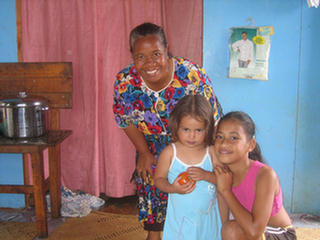
Sunday’s slight
break in the weather failed to hold, and seriously
crappy weather with rain and high winds set in for the
next week. About this time I got an email back from
Cruising World Magazine with a green light for several
articles I’d pitched, so the weather-enforced hiatus
from sun and fun was timely for me. It made better
sense for us to spend the week in town, so we braved the
high seas to sail back to a mooring in Neiafu. |